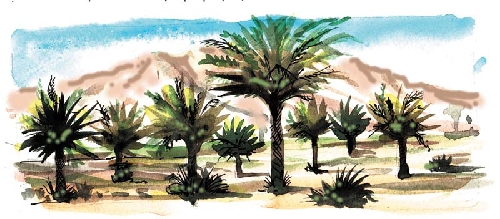China Ranch Date Farm prospers in remote oasis

Located in a secluded California desert canyon near Death Valley National Park, China Ranch Date Farm surprises first-time visitors. At the end of a twisting road between chalky cliffs cut into desert seemingly barren of plant life, this hidden oasis fills a little valley with groves of stately date palms, stands of cottonwoods and thickets of vegetation amid the sound of trickling water. Visitors discover date processing and packing sheds, a bakery, snack bar, gift shop, landscaping nursery, a one-room museum and miles of hiking trails.
China Ranch makes an excellent destination during the cooler months. It’s less than 90 miles from Las Vegas near the communities of Tecopa and Shoshone, just off a major route to Death Valley. To reach the farm, follow Interstate 15 south to Highway 160, the route west through Mountain Springs Pass to Pahrump.
When the highway nears the mountains, it parallels the historic Old Spanish Trail, the route from New Mexico to California established by Antonio Armijo in 1830. Once over the mountains and down into Pahrump Valley, watch for the turnoff for the Tecopa Highway, which becomes the Old Spanish Trail Highway at the California border.
As you approach Tecopa, a community developed around natural hot springs, a lake and marshes, watch for Furnace Creek Road. Turn left and drive a couple of miles to the junction with China Ranch Road. Turn right onto this short, unpaved route, which soon drops into a canyon and winds past old mining ventures to the oasis.
Visitors to this working family farm receive free samples of several kinds of dates during a visit to the farm’s gift shop, which features baked goods made with dates and a snack bar where you can order a delectable date shake.
The shop stocks an array of food, including assorted packaged dates, jams, jellies, candies, books, souvenirs, toys and handcrafted items. The nearby plant nursery offers palms, cactuses and native plants. Stop by the one-room museum for glimpses of the past at China Ranch.
The ranch has been cultivated for about 130 years since an enterprising Chinese man left his labors in borax production in nearby Death Valley to start a truck garden in the little canyon, where a creek provided plenty of water. He supplied fresh vegetables, fruit, poultry and eggs to various mining camps in the late 1800s.
Eventually pushed aside, the laborer-turned-farmer disappeared, not even leaving his name behind. But the property retained the name Chinese Ranch, later shortened to China Ranch, as it has been known through several subsequent owners. The first date palms were planted in the 1920s.
In 1970, members of the pioneering Brown family acquired the ranch and began expanding and improving the property.
Since it takes palms many years to become mature enough to produce dates, managing the groves means a long-term investment of labor and a lot of planning. Brian Brown gained expertise in the field, while wife Bonnie developed and tested ways to use the nutritious dates in various recipes, such as the breads, muffins, cakes and cookies available in the ranch bakery and the recipes in cookbooks stocked in the gift shop.
The couple even built their own spacious ranch house, a comfortable, four-bedroom home of 4,500 square feet constructed of adobe bricks made at the ranch. The project took five years starting in 1991.
China Ranch draws many repeat visitors. It has become a hot spot for birders because the China Ranch Creek and the nearby Amargosa River create a wetlands retreat for resident and migratory birds. More than 225 species of birds have been spotted in the area. Native wildlife is also drawn to the water, trees and vegetation, but you are far more likely to see their tracks than the elusive critters.
The ranch owners promote exploration of the area on foot and horseback. Inquire at the gift shop or museum about maps for six trails radiating from the ranch. The easiest explores the ranch grounds and groves, where there are sites for picnicking. Of varying lengths and difficulty, the other trails explore the Amargosa River Canyon, a nearby slot canyon, the route of the historic Tonopah and Tidewater Railroad and beautiful desert and canyon landscapes.
Margo Bartlett Pesek’s Trip of the Week column appears on Sundays